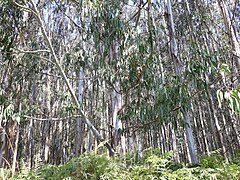
For the most part, the history of forestry in Spain was one of increasing deforestation.[1] Wood (Spanish: madera) long was the main source of energy.[1] In the 20th century, efforts were taken to reverse the trend, increasing the forested area in the country from then on.[2][n. 1]
Forests cover roughly 55% of the land in Spain, with 70% privately owned and 27% on public land. The former amount wildly changes depending on the region, with Navarre accounting for the largest share of publicly owned forest and Galicia the smallest (MAGRAMA, 2012).[4]
As of 2012, the most common tree species in Spanish forests are Pinus pinaster, Pinus sylvestris, species of eucalypts, Pinus halepensis, Fagus sylvatica, Pinus nigra, Quercus ilex, Quercus pyrenaica, Quercus pubescens, Pinus radiata, Quercus robur and Quercus petraea.[5]
Forestry policy at the state level is included as part of the policy area of rural development of the relevant ministerial department.[6] Much of the management of forestry, however, has been transferred at the regional level to different autonomous communities.[5]
-
Quercus pyrenaica marked for logging near the N-110 (1976)
-
Reforestation in La Huerce (1977)
-
Eucalypt plantations in Palas de Rei (2019)
References
[edit]- Informational notes
- ^ Concern about the increasing pressure over woodland was already present in the Middle Ages in the Iberian Peninsula, though. An early case (considered one of the earliest recorded in Europe) of reforestation took place in 1276 in the Monastery of Oña.[3]
- Citations
- ^ a b Valbuena-Carabaña et al. 2010, p. 492.
- ^ Valbuena-Carabaña, María; López de Heredia, Unai; Fuentes-Utrilla, Pablo; González-Doncel, Inés; Gil, Luis (2010). "Historical and recent changes in the Spanish forests: A socio-economic process". Review of Palaeobotany and Palynology. 162 (3): 492. doi:10.1016/j.revpalbo.2009.11.003.
- ^ Wing, John T. (2012). "Keeping Spain Afloat: State Forestry and Imperial Defense in the Sixteenth Century". Environmental History. 17 (1): 121. doi:10.1093/envhis/emr123. JSTOR 23212618.
- ^ Freitas 2016–2017, p. 40.
- ^ a b Freitas 2016–2017, p. 41.
- ^ Freitas, Ester Oliveira de (2016–2017). "Effects of national forest governance structures on the adoption of EU Forestry Strategy: an analysis in selected Mediterranean countries" (PDF). p. 41.




